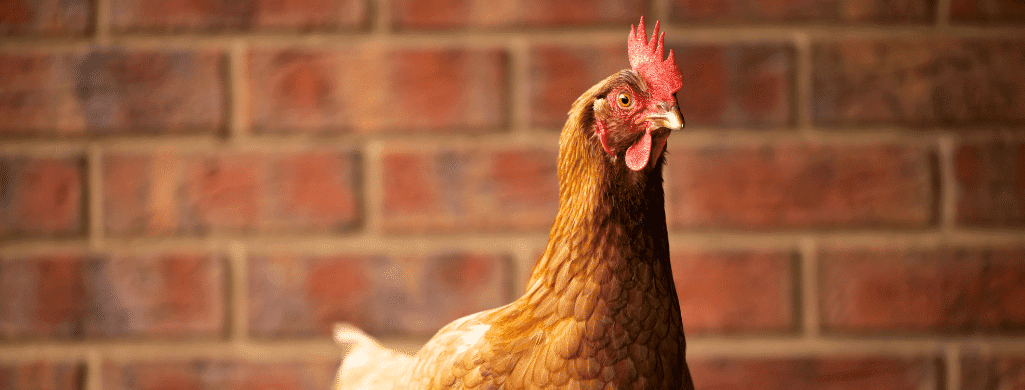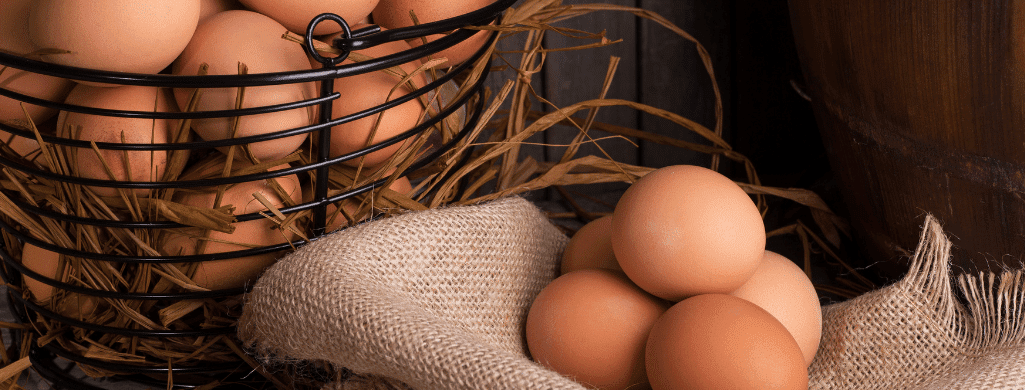The ISA Brown is a popular chicken breed loved by backyard chicken keepers for its docile temperament, ease of care, and of course, its egg-laying capabilities.
ISA stands for “Institut de Selection Animale,” which is the name of the French company that developed the breed in 1978.
These hybrid chickens are a cross between Rhode Island Reds, Rhode Island Whites, and several other chicken breeds.
The result is a beautiful bird with coppery feathers, hardiness against various climates, and the ability to lay an abundance of eggs.
ISA Browns are also affectionate chickens and are often kept as family pets.
Since ISA Browns are hybrid chickens specifically bred for commercial egg production, the hens begin laying at an early age and are one of the top egg producers of any breed.
Keep reading to learn more about the egg-laying habits of ISA Brown chickens.

Table of Contents
ToggleAre ISA Brown Hens Good Egg Layers?
ISA Brown hens are prolific egg layers, often laying anywhere from 300 to 350 large brown eggs in one year. On average, your ISA Brown chicken will lay six or more eggs weekly. ISA Brown chickens were bred for commercial egg production, so they are very consistent layers.
The eggs from an ISA Brown hen are brown in color and range in size from large to extra large.
Up to 60% of the brown eggs you see at the grocery store come from ISA Brown hens.
Many people buy brown eggs because they are believed to be healthier than white eggs.
This is a myth, as brown eggs contain the same nutritional value as white eggs and do not taste any different.
Some chefs prefer to use brown eggs, but only because they purchase them from local farmers for guaranteed freshness.
Since ISA Brown hens are prolific layers, they need more protein and calcium in their diet than other backyard chicken breeds.
Provide your hens with a layer feed containing at least 18% protein and oyster shells for extra calcium.
A high-quality feed like this one has 19% protein and includes oyster shells, vitamin D, and manganese for strong egg shells.
You must also provide your chickens with plenty of fresh water to prevent dehydration.
When Do ISA Brown Chickens Start Laying Eggs?
ISA Brown hens start laying eggs when they are between 18 to 22 weeks of age. This egg-laying age is common among most hybrid breeds of chickens and much earlier than heritage breeds. An ISA Brown’s living environment and the time of year also influence when the hens will begin laying.
Chicks born in late summer or fall will not reach maturity until the cold, dark winter months.
These hens may not start laying eggs until the spring when the weather is warmer and there are more daylight hours.
There are several signs an ISA Brown hen is getting ready to lay eggs.
You may notice your hen’s comb and wattle appear larger and darker red in color.
The color change and swelling of the comb and wattle are caused by shifting hormones in the hen’s body.
In the weeks before your ISA Brown starts to lay eggs, she may suddenly become very interested in the nesting box area.
If the hen is sitting in the nesting box and being extra chatty, this is another sign she may lay eggs soon.
It is not uncommon for hens to sing what is known as the “egg song” before and after laying eggs.
As a young hen matures and her hormones change, she will have an increased appetite.
Switch your hens from a starter feed to a layer feed with extra protein when they are 18 weeks old or when they lay their first egg, whichever comes first.
Oyster shells may be given as free-choice feed for extra calcium.
Another sign your ISA Brown hen is getting ready to lay eggs is she will start doing what is known as a submissive squat.
She may squat low to the ground and spread her wings whenever you approach the hen.
This squatting behavior means the hen is ready to mate with a rooster to fertilize the eggs she is about to lay.
When no rooster is present, the hen may exhibit this behavior around humans.

How Many Years Will ISA Browns Lay Eggs?
Egg production peaks in ISA Brown hens when they are two years old before it begins to decline or stop altogether. This short egg-laying period is due to ISA Brown’s shortened lifespan, which averages only 3-5 years.
ISA Brown chickens were bred purely for egg production.
The size of ISA Brown chickens is relatively small compared to other breeds.
ISA Brown hens typically weigh about five pounds, and roosters top out at only six pounds.
Laying lots of eggs takes a toll on an ISA Brown hen’s small body, contributing to a shorter lifespan.
It is very uncommon for an ISA Brow chicken to live past five years of age.
There is anecdotal evidence of a farmer who claimed to have a 7-year-old ISA Brown chicken, and she still laid eggs.
While there are several recorded cases of ISA Browns living for as long as eight years, an extended lifespan is extremely rare for laying hens of this breed.
How Long Will ISA Browns Lay For?
ISA Brown chickens can adapt well to hot and cold temperatures and are known to lay eggs all year. It is common for ISA Brown hens to take a brief break from laying eggs when they molt in the fall. Once the molting process is complete, the hens resume laying in about 8-12 weeks.
Extended daylight hours and warm weather usually trigger egg production, and many breeds of chickens do not lay eggs in the darker winter months.
Some farmers use artificial lighting to encourage their hens to lay all year, but this is not healthy for the chickens and may cause them to become stressed.
Most cold-hardy chicken breeds do not have any problems laying eggs in the winter.
Winter egg production is usually slightly lower; the peak egg-laying season is in the summer.
ISA Brown chickens are hardy birds and do well in hot and cold climates.
Your ISA Brown hen may stop laying eggs if she is stressed or sick.
If you notice changes in your hen’s appetite, or other signs of illness, such as lethargy or discharge from the eyes, seek veterinary care right away for treatment.

Do ISA Brown Hens Go Broody?
ISA Brown hens are extremely focused on egg production, so they rarely go broody. When an ISA Brown hen does go broody, she will faithfully sit on her eggs. ISA Brown hens are also known for being excellent mothers.
Broody hens will rarely leave the chicken coop unless it is to eat, drink, or use the bathroom.
Breeding ISA Brown chickens are often very challenging.
ISA Brown hens spend most of their short lives laying eggs and rarely have time for mating.
Since ISA Brown chickens are a hybrid breed, there is no standard for their appearance.
The lack of a breed standard makes it impossible to breed these beautiful birds for show purposes.
Chicks born from ISA Brown hens do not retain the breed characteristics of the parents, and there is a tendency for them to have kidney problems.
Can ISA Brown Chickens Lay White Eggs?
ISA Brown chickens mostly lay brown eggs, but it is not uncommon for a hen to occasionally lay a white shell egg. The eggs from an ISA Brown hen tend to be darker at the beginning of the season, and then the color gradually becomes lighter.
You will most likely see a pale tan or white shell egg just before the hen molts.
There is only so much pigment in an ISA Brown hen’s body.
The more eggs she lays, the lighter they are in color, almost like a printer running out of ink.
After the ISA Brown hen has molted and taken a break from egg laying, she will begin producing darker brown eggs in the next laying season.
Another variation to the breed is known as the ISA White chicken, which lays white eggs.
The ISA White chicken is rarer than the ISA Brown, but the only difference between them is the color of their feathers.
ISA Brown’s feathers are copper in color, while ISA Whites have white feathers.
ISA White chickens share the same docile temperament and egg-laying capabilities as the ISA Browns.

Can You Incubate ISA Brown Eggs?
It is possible to incubate ISA Brown eggs if you know your hen has mated with a rooster and the eggs are likely fertile. You will incubate ISA Brown eggs like any other chicken eggs. A commercial incubator is recommended for the best hatch rate.
If your ISA Brown hen is not broody and you want the eggs to hatch, you will need to do it yourself.
A commercial incubator makes the process much easier than using a homemade incubator, as it is excellent in temperature and humidity regulation.
The best temperature for successful chicken egg incubation is 99.5° degrees Fahrenheit (37.5° C).
Maintaining humidity levels between 40 to 50% for the first 18 days is crucial before increasing them to 65-75% just before the eggs hatch.
The incubator must also have proper ventilation to allow oxygen into the porous egg shells.
You must monitor the temperature and humidity levels throughout the process to ensure they remain steady.
Can You Hatch ISA Brown Eggs?
When your ISA Brown hen is not interested in hatching her eggs, you may hatch them yourself in an incubator. Using a commercial incubator will give you a more successful hatch rate, as the device is much better at maintaining steady temperatures and humidity levels.
If the temperature or humidity level inside the incubator is incorrect, even for just a few hours, the eggs may not hatch.
Most incubators have a built-in sensor to tell you the temperature and humidity levels.
Otherwise, you will need to invest in a quality thermometer and hygrometer to ensure the incubator has the proper environment for hatching.
Do not candle the eggs too often to see if they are viable, as this could disrupt the incubation process.
It takes an average of 21 days for ISA Brown eggs to hatch.
When the first couple of eggs begins to hatch, the peeping noises of the baby chicks will encourage the others to hatch.
If there are unhatched eggs after two days of the others hatching, they are not likely to be viable.
Removing infertile eggs from the clutch is important, as the eggs may begin to rot and spread harmful bacteria.
A good hatch rate is from 70-80% percent, so do not be alarmed if some eggs do not hatch.
How useful was this post?
Click on a star to rate it!
We are sorry that this post was not useful for you!
Let us improve this post!
Tell us how we can improve this post?
